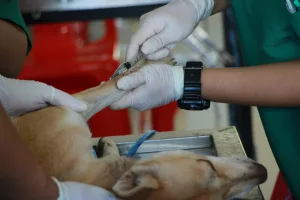Cats purring is one of the most intriguing behaviors exhibited by these fascinating creatures. While it may seem like a simple expression of contentment, there is actually a complex biological reason behind why cats purr. Purring for Communication One of the primary reasons why cats purr is for communication. Kittens purr to let their mother know that they are content and safe, and adult cats use purring to communicate with their human companions. It is thought that the frequency of the purring can convey different messages, such as a request for food or attention. Purring serves as a means of bonding and connection between cats and their human caregivers, creating a unique form of communication that strengthens their relationship through shared understanding and emotional resonance.
Purring as a Language
Cats may not have the ability to speak in a human language, but their purring serves as a kind of language all its own. A specific example of this is the “solicitation purr,” which combines a purr with a higher-pitched meow often used to request food from their human companions. This type of purr has a frequency that is particularly hard for humans to ignore, which showcases the cleverness of cats in ensuring their needs are met.
Purring and Social Dynamics
In multi-cat households, purring can play a significant role in social dynamics. Cats may purr to show submission or to signal peaceful intentions when meeting new cats. Observing this in a household can help you understand the hierarchy and relationships among your cats, providing insights into their social interactions. For example, if a new cat is introduced and the existing cat starts purring, it might be an attempt to ease tension.
Self-Healing Properties of Purring
Interestingly, studies have shown that the act of purring can have self-healing properties for cats. The vibrations produced by purring have been found to promote healing of muscles, tendons, and bones, enhancing their overall physical well-being. Purring is also believed to release endorphins, which are natural painkillers, and can help cats heal faster from injuries, demonstrating the intricate link between sound, vibration, and physiological healing processes in felines.
How Purring Affects Healing
The frequency of a cat’s purr, typically between 25 and 150 Hertz, is within a range known to be medically therapeutic for humans too. This frequency range can help stimulate bone growth, reduce inflammation, and repair tendons. For instance, a study involving cats with broken bones showed that those who purred frequently healed more quickly than those that did not. This self-healing capacity might explain why cats often curl up and purr when they are unwell or stressed, as it’s an instinctive response to facilitate recovery.
Practical Applications for Cat Owners
As a cat owner, you can support your cat’s self-healing processes by ensuring they have a comfortable, quiet space where they can relax and purr undisturbed. Providing a warm, cozy environment can encourage your cat to engage in this natural healing behavior, particularly after veterinary visits or stressful events.
Stress Relief and Emotional Connection
Another reason why cats purr is for stress relief and emotional connection. Cats may purr when they are feeling anxious or fearful as a way to comfort themselves, providing a source of solace and reassurance in times of distress. Additionally, the rhythmic sound of purring can have a calming effect on both the cat and their human companions, fostering a stronger emotional bond between them. This mutual exchange of soothing sounds creates a harmonious environment that promotes relaxation and emotional well-being for both parties.
Purring and Human Health
The calming effect of a cat’s purr extends beyond the feline world. For humans, spending time with a purring cat can lower blood pressure, reduce stress levels, and even decrease the risk of heart disease. There’s something inherently soothing about the gentle vibrations and rhythmic sound of purring that can help alleviate anxiety.
Creating a Calming Environment
To maximize the calming effects of a cat’s purr, consider creating a serene environment in your home. This might include setting up a quiet corner with soft bedding and dim lighting where your cat feels secure and inclined to purr. Not only will this enhance your cat’s comfort, but it can also become a peaceful retreat for you, a place to unwind together.
Evolutionary Origins of Purring
The exact evolutionary origins of purring in cats are still debated among experts. Some believe that purring evolved as a way for mother cats to communicate with their kittens, facilitating maternal care and bonding within feline families. Others suggest that it may have developed as a means for cats to soothe themselves in stressful situations, serving as a self-soothing mechanism that aids in emotional regulation. The evolutionary origins of purring highlight the adaptive significance of this unique vocalization in the survival and social dynamics of domestic cats.
Purring in the Wild
Observing wild cat species provides additional insights into the evolutionary roots of purring. Big cats like cheetahs and mountain lions also purr, but typically only during exhalation and not continuously like domestic cats. This suggests that purring may have originally served as a non-threatening signal to other animals or as a way for mothers to keep track of their young in dense vegetation.
Adapting Purring for Domestication
As cats became domesticated, their purring likely adapted to fit new social structures and relationships with humans. The ability to purr continuously while inhaling and exhaling might have developed to facilitate stronger human-cat bonds, enhancing the cat’s role as a companion animal. This adaptation underscores the complex interplay between evolution and domestication in shaping feline behavior.
Common Misinterpretations of Purring
While purring is often associated with happy, content cats, it’s important to recognize that cats may also purr when they are in pain or distress. This multifaceted behavior can sometimes lead to misunderstandings between cats and their human companions.
Recognizing Different Purring Contexts
To better interpret your cat’s purring, pay attention to the context and accompanying body language. A cat that is purring while relaxed, kneading, and closing its eyes is likely content. In contrast, a cat that is purring while hiding, showing signs of distress, or refusing food may be using purring as a coping mechanism for discomfort or anxiety.
Tips for Accurate Interpretation
- Observe Body Language: Look for cues such as tail position, ear orientation, and eye movements to determine your cat’s mood.
- Consider the Environment: Note any changes in the home or routine that might be affecting your cat’s behavior, such as new pets, visitors, or alterations in their territory.
- Consult a Veterinarian: If you suspect your cat is purring due to pain or illness, a veterinary check-up can help rule out any medical issues.
Practical Tips for Enhancing the Cat-Human Bond
Understanding the various reasons behind a cat’s purring can greatly improve the way you interact with your feline friend. Here are some practical tips to enhance your bond through the power of purring:
Encourage Positive Purring
- Create a Comfort Zone: Provide a safe space where your cat feels secure and relaxed. This can be a quiet room or a cozy bed where your cat can retreat to whenever they need comfort.
- Use Gentle Touch: Cats often purr when being petted, so use gentle strokes to elicit purring and reinforce positive interactions.
- Interactive Play: Engage your cat in play that stimulates both mind and body. This can lead to contentment and, subsequently, purring.
Strengthen Communication
- Respond to Solicitation Purrs: When your cat uses a solicitation purr, acknowledge their request for food or attention to strengthen your communication.
- Learn from Your Cat: Pay attention to your cat’s unique purring patterns and what they correspond to, enhancing your understanding of their needs and emotions.
Overall, the act of purring in cats is a complex and multifaceted behavior that serves various biological and social functions. By understanding the science behind why cats purr, we can deepen our appreciation for these enigmatic and beloved companions, recognizing the depth of their communication, healing abilities, and emotional connectedness with humans. The mesmerizing phenomenon of purring underscores the intricate nature of the feline-human bond, enriching our relationships with these mysterious and endearing creatures. Engaging with your cat’s purring not only supports their well-being but also enriches your own life with warmth and affection.



